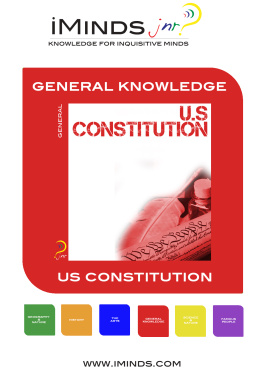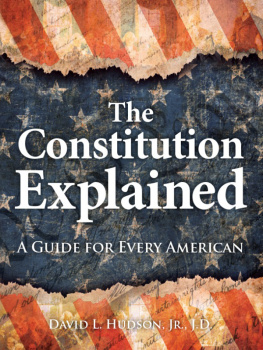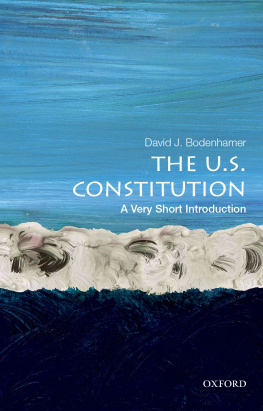MORE ADVANCE PRAISE FOR THE CONSTITUTION

A sharp, efficient guide to the creation, content, and construction of the supreme law of the land.... A well-conceived, well-executed primer.
Kirkus Reviews
This wonderful work is the best introduction to the United States Constitution available. It does a brilliant job reviewing two-and-one-quarter centuries of American experience. Essential reading for those who still believe in ordered liberty and self-government.
Stephen B. Presser, Raoul Berger Professor of Legal History, Northwestern University, and author of Recapturing the Constitution
This is a unique and uniquely valuable book. The Paulsens weave historical context, doctrinal reflection, and personal stories into a narrative that explains how the Constitution has become what it is in twenty-first century America. In doing so, the book appeals both to legal scholars and to a popular audience that often struggles to make sense of the constitutional battles of our day. This is the one book that I recommend to anyone who wants a comprehensive and enjoyable overview of the Constitution, what it means, and why it matters.
John Copeland Nagle, John N. Matthews Professor of Law, University of Notre Dame


Copyright 2015 by Michael Stokes Paulsen and Luke Paulsen
Published by Basic Books,
A Member of the Perseus Books Group
All rights reserved. Printed in the United States of America. No part of this book may be reproduced in any manner whatsoever without written permission except in the case of brief quotations embodied in critical articles and reviews. For information, address Basic Books, 250 West 57th Street, New York, NY 10107.
Books published by Basic Books are available at special discounts for bulk purchases in the United States by corporations, institutions, and other organizations. For more information, please contact the Special Markets Department at the Perseus Books Group, 2300 Chestnut Street, Suite 200, Philadelphia, PA 19103, or call (800) 810-4145, ext. 5000, or e-mail .
Photo credits: Chicago Historical Society: p. 192; Des Moines Register photo, published with permission: p. 293; Gunston Hall: p. 15 (top); Japanese American Archival Collection. Department of Special Collections and University Archives. The Library, California State University, Sacramento: p. 241; Library of Congress: pp. 10, 15 (bottom), 33, 49, 84 (all), 87, 140, 145, 146, 153, 158, 163, 179, 206, 209, 214, 224, 238, 253, 311; Phoenix Police Department: p. 267; Wikimedia Commons: pp. 12, 14 (all), 15 (middle), 85, 151, 211; 2014 VirtueMedia, Inc., Used with permission: p. 271.
Designed by Cynthia Young in Adobe Garamond Pro.
Library of Congress Cataloging-in-Publication Data
Paulsen, Michael Stokes, author.
The Constitution : an introduction / Michael Stokes Paulsen and Luke Paulsen.
pages cm
Includes bibliographical references and index.
ISBN 978-0-465-05371-1 (e-book)
1. Constitutional historyUnited States. I. Paulsen, Luke, author. II. Title.
KF4541.P386 2015
342.7302'9dc23
2014041943
10 9 8 7 6 5 4 3 2 1
For Kristen Paulsen and Caroline Paulsen
CONTENTS


OUR GOAL IN THIS BOOK is to provide a reasonably short, reader-friendly, intelligent introduction to the United States Constitution in all respectsits formation, its content, and the history of its interpretation.
That is a simple, straightforward goal, but also a surprisingly difficult one to achieve. Most books on the American Constitution, it seems, tend to fall into one of two unsatisfactory categories. There exist a fair number of sophisticated, massive scholarly tomes on the Constitution, its interpretation, or the history of the Supreme Court. This is not one of them. There are also plenty of short, near-cartoonish, slapdash popular treatments of the Constitution. This is not one of those either.
Our aim lies right in between: to offer a book that is sufficiently comprehensive to serve as a general introduction to the Constitution, but not a bloated treatise that only a few would dare read. We have sought to produce a book that is rigorous, accurate, and scholarlyyet still as provocative as its subject, the Constitutionand at the same time brief and readable. In short, this aims to be a smart book but not a ponderous one. We strive to be as objective as possible. But the history of the Constitution is a lively story of ideas, disputes, and controversies, not a bland set of facts, and this book reflects that reality. We take some definite positions and throw a few puncheshopefully, in the right places.
Our (somewhat immodest) hope is that The Constitution: An Introduction might serve as the definitive modern primer on the US Constitution. The book embraces the subject of the Constitution in its full compass: The narrative begins with the forces that led to the documents formation in the Philadelphia Convention of 1787. It proceeds with a brisk but thorough examination of the Constitutions key structural features: its allocation of powers among the branches of the national government; its provisions defining relationships among the states of the Union and between the states and the nation as a whole; its unfortunate accommodation of slavery; and its nearly immediate amendment to include a Bill of Rights. It then completes the storyin the second half of the bookwith a brisk history of the major controversies and issues that have surrounded the Constitutions interpretation over its 225-year life span: from the foundational constitutional disputes of the early years of the Washington administration; through secession, Civil War, and emancipation under Lincoln; to the contentious modern constitutional issues of the past sixty years.
The book itself has an interesting story behind it. My son Luke and I wrote the book as a father-son project over the course of nine summer vacations, from 2006 to 2014, spanning Lukes high school and college years.
The initial idea grew out of a friendly argument following an academic presentation I made at Princeton University in the winter of 2006. At the informal dinner that followed, a debate broke outsometime around the second bottle of winebetween the law professors and the college professors in attendance over exactly when, where, and how law students had come to possess such thoroughly engrained misconceptions about the Constitution, constitutional history, and constitutional law. The law professors, of course, blamed the college professors. What are you teaching people? The college professors insisted that students came to them in this already misshapen condition. Its not our fault. They came to us this way.
I ventured that someone really ought to write a book aimed both at studentsto keep them from forming mistaken notions about the Constitution in the first placeand at general,
Next page







